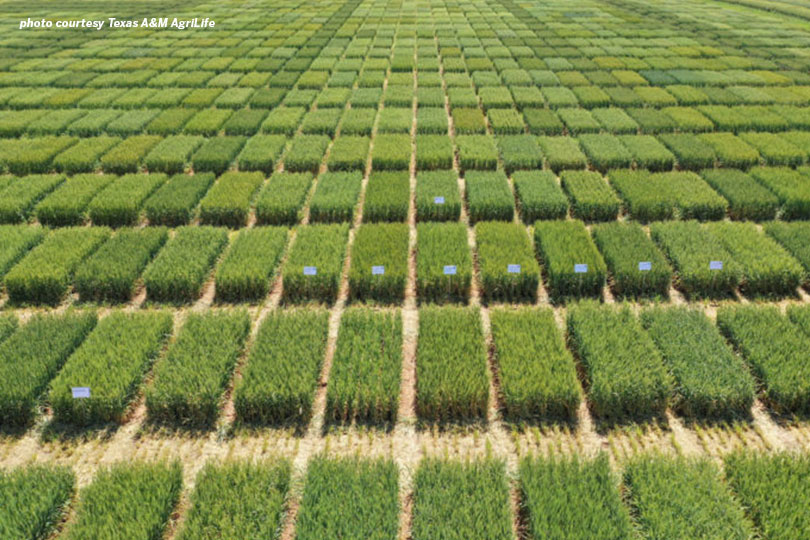By Jennifer Dorsett
Field Editor
Due to COVID-19, Texas A&M AgriLife moved its annual wheat tour online—bringing the field to the farmer in a digital format.
The 2020 Virtual Wheat Tour features videos of different locations so farmers can view the field trials and learn about the latest research, according to Fernando Guillen, Texas A&M AgriLife Extension Service statewide small grains and oilseed crops specialist.
For this year’s tour, winter wheat uniform variety trials (UVT) were planted at 23 sites across the state in 18 different geographic locations to evaluate various lines of wheat under irrigated and dryland conditions.
The studies are a collaborative effort between AgriLife Research wheat breeders Jackie Rudd in Amarillo and Amir Ibrahim in College Station and AgriLife Extension agronomists and county agents.
Different varieties and experimental lines developed by Texas A&M AgriLife, along with varieties from other universities and private companies, are studied in the UVTs. Data and results from the test plots are used to make variety recommendations to farmers in four growing regions: High Plains, Rolling Plains, Blacklands and South Texas.
Guillen said the 2020-2021 recommendations will be posted in early August.
Varieties selected are based on grain yield; disease and insect resistance; end-use quality and stability; or consistent performance across locations over time.
In the High Plains, there were three irrigated and three dryland trials in the Bushland, Groom, Perryton, Dumas and Dalhart areas. Thirty-four varieties were planted on dryland plots and 36 on irrigated.
Dryland trials included eight Texas A&M AgriLife (TAM) varieties, four new experimental TAM lines, nine from other universities and 13 from the seed industry.
The irrigated trials had eight TAM varieties, three experimental TAM lines, 11 from other universities and 14 from private industries. Those trials are in the final stages of development and not yet harvested. This year, no Panhandle trials were lost due to weather conditions.
In the Rolling Plains, dryland trials were conducted near Abilene, Chillicothe, Munday and San Angelo. A total of 31 varieties were tested, including five TAM varieties, five experimental TAM lines, five from other universities and 16 from private industry. The plot at Chillicothe was impacted by freeze and hail damage.
The Blacklands area had trials in Ellis, Hillsboro, McGregor, Muenster, Thrall and Prosper, all under dryland conditions. The Thrall plot experienced significant damage from cattle and was declared a loss. Harvest is currently underway at most locations. Twenty-three varieties were planted:–four TAM, four experimental TAM lines, one from another university and 14 from private industry.
Dryland trials in South Texas were planted at Castroville, College Station, Eagle Lake and Uvalde. Twenty varieties were planted, including four TAM, five new experimental TAM lines, one from another university and 10 from private industry. Harvest was completed in May.
The latest U.S. Department of Agriculture (USDA) crop and weather progress report shows 72 percent of Texas’ winter wheat crop is in fair or better condition. As of mid-June, about 68 percent of harvest is complete.
Leaf rust was a problem again in the southern regions of the state, but not as much as in previous years, according to Ibrahim.
“We had some freeze damage in some of the early lines in South Texas and Central Texas,” he said. “We had freezing temperatures in February after the wheat had started to joint. The freeze in Uvalde and Castroville came when the stems were elongating and caused the damage.”
Overall, the area experienced good moisture and timely rains, although rains slowed or impeded field operations in some areas. All locations other than the Blacklands were expected to see average yields.
“It’s been wet in many areas of the Blacklands, so much so that we didn’t get to apply second dose of nitrogen this year,” he said. “Our yields were 50 to 60 bushels per acre instead of the 70 or 80 bushels per acre we typically see there.”
But the weather provided the optimum conditions to find the hardiest varieties, Rudd added.
“The reason our varieties are such strong performers under stress is because they have been bred and selected under stress,” Rudd said.
Throughout the past three years, there have been large variations in growing conditions—exactly what is needed to see how a new variety fares under different circumstances.
“This gives us a good diversity of what we need when looking at different germplasm. Since breeding is a long multi-year process, something that can do really well in all three years are definitely keepers,” Rudd said.
Many of the plots on the tour saw freeze and hail damage in the High Plains, according to Rudd. Recent high winds caused some shattering in wheat lines that were not bred for the High Plains.
“Our target environment is a tough place, and we need lines that will survive all these conditions,” he said. “There are several experimental lines coming through the pipeline that we feel very good about. What we have in the pipeline are better than the existing varieties. The process works.”
Click here to see more about the trial results and to view the 2020 Wheat Tour.

